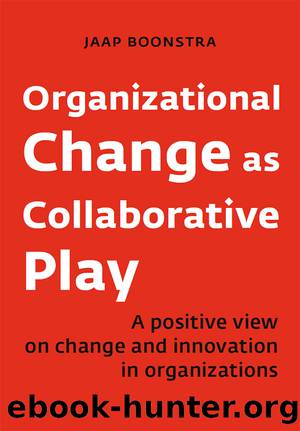Organizational Change As Collaborative Play by Boonstra Jaap;

Author:Boonstra, Jaap;
Language: eng
Format: epub
Publisher: Vakmedianet Management B.V.
Language and narrative
Players in change use language to express the necessity of change and to visualize the future. They clarify a vision and a strategic course in understandable and appealing language in order to motivate employees to change. For the sake of credibility it is desirable that top managers are visible. Change managers often use written communication in the form of newsletters, intranet bulletins, stories, booklets, cards with core values or a new house style. Board members and administrators use video messages, staff sessions, lunch meetings and informal meetings. Here communication is a one-way process, but it is important that it does not stay that way. Communication goes deeper when it is two-way and not only used as reassurance. Players then enter into discussions with each other to explore and clarify problems and ambitions further. Players are invited to make themselves heard and asked if they want to produce ideas and contribute to the change. It is precisely in these interactions that meaning is generated and a story is created about the change that generates involvement. A profound change only succeeds when the communication reaches the deeper layers of the identity of the organization and the people involved have the opportunity to exchange meanings.
If the change history is rather problematic, concerning a particular issue, and prevailing opinions in the organization are counter-productive, the change concept will rarely resonate well. This is not because it does not work, but because it has never been dealt with this way. It may then help to find out why changes have not worked well up to now. Only with that awareness is an unknown route likely to be acceptable. In this case, the starting point for change is not an approach that is in line with what people expect, but a shared understanding of why previous changes did not lead to the intended result and what this means for the approach to the change that the players have in mind now.
Making change stories
In most organizations, all sorts of stories circulate about changes and players who have played, or are still playing, a role in them. In these organizational stories, players assign meanings to situations, express discomfort and enthusiasm, enter into relationships with others and make their work meaningful. There are stories about people who have put their necks on the line and what happened, about special change agents, heroes, victims, friends and enemies. These stories provide insight into play patterns that are often felt to be elusive. Organizational stories indicate what is happening in an organization and are thus important for selecting and implementing the play concept.
Stories are also useful in defining and realizing changes in organizations. They can provide insight into relationships, undercurrents and hidden emotions. They can also help to put the change into words and motivate players to participate in the change. A change story is a story of events that combine with each other. A good change story stands alone and has a beginning, middle and an end. The story
Download
This site does not store any files on its server. We only index and link to content provided by other sites. Please contact the content providers to delete copyright contents if any and email us, we'll remove relevant links or contents immediately.
AI Native Enterprise: The Leader's Guide to AI-Powered Business Transformation by Yi Zhou(236)
Challengers: How a New Breed of Leaders Collaborates and Wins in a Hyper Competitive World by Ben-Attar Saar(225)
Stoic at Work by Annie Lawson(192)
Time is Now: A Journey Into Demystifying AI by Raj Verma(182)
Change Management that Sticks by Barb Grant(167)
Impact with Love: Building Business for a Better World by Greg Harmeyer(157)
Leadership Team Alignment by Frédéric Godart(153)
Startups Grow With People by Dagdeviren Ozan(150)
People and Data by Redman Thomas C.;(142)
9 Powerful Practices of Really Great Teams by Stephen E. Kohn(134)
Reconstructing Inclusion by Amri B. Johnson(134)
You're Too Smart for This : (Beating the 100 Big Lies About Your First Job) by Michael Ball(133)
How to Speak Human by Jackson Dougal;Jackson Jennifer;(127)
Change Your Business with NLP by Lindsey Agness(123)
Leading and Managing Change in the Age of Disruption and Artificial Intelligence by Donald Mathew;(123)
Corporate Fraud Exposed by Baker H. Kent;Purda Lynnette;Saadi Samir;(123)
The Executive Warrior by Ng Victor;(120)
Leadership Transitions by Richard Elsner(111)
Outpacer by Alex Holt(109)
